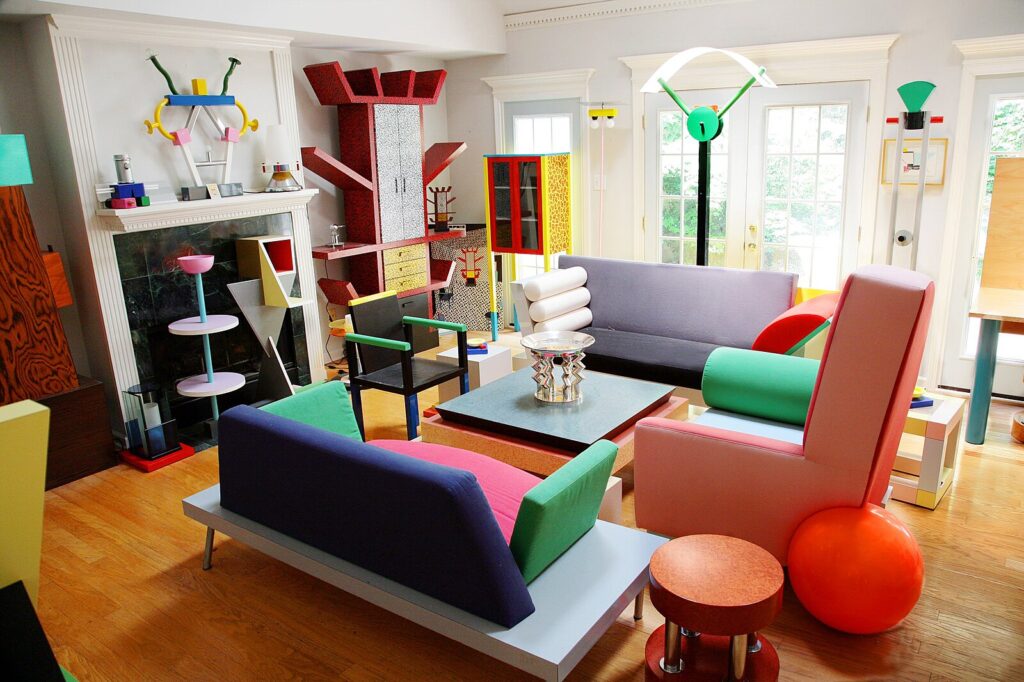In the vibrant landscape of 20th-century design, few movements have left as lasting of a mark as the Memphis Movement.
With its bold colors, quirky shapes, and playful irreverence, the Memphis Movement emerged in the 1980s. It was a rebellious response to the prevailing minimalism of the Modernist era.
The Memphis movement was a design revolution that continues to captivate and inspire to this day, defined by distinct principles and a lasting legacy.

Origins and Influences
The Memphis Movement was founded in Milan, Italy, in 1981. It was founded by a group of young designers led by architect Ettore Sottsass.
Sottsass and other architects were hoping to shift the mainstream design philosophy away from Modernism and towards something new. They spent months creating hundreds of drawings for a new style.
Named after the Bob Dylan song “Stuck Inside of Mobile with the Memphis Blues Again,” the movement drew inspiration from a wide range of sources. These included Art Deco, Pop Art, and the avant-garde movements of the early 20th century.
Sottsass chose Memphis as a name because the song played on repeat while the architects discussed aspects of the new design. Also because it was ambiguous between the ancient Egyptian city and the modern city in Tennessee.
The Memphis Group rejected the self-righteous and purely pragmatic nature of modernist design. They sought to inject a sense of joy, spontaneity, and whimsy into the world of interiors and products.
Their designs were characterized by bold colors that often clashed with each other. This included geometric shapes that highlighted sharp angles.
Also, unconventional materials that drew comparisons between high and low art. This challenged the conventions of traditional design and blurred the boundaries between art and function.
Aesthetic dominated over function as the Memphis Group focused on creating bright, joyful art, but usefulness was still a key component of the designs.

Key Principles and Aesthetics
At the heart of the Memphis Movement were several key principles that set it apart from other design movements of the time.
One of the most notable was the embrace of kitschy materials. These are materials that typically hold little or no depth of meaning such as plastic laminate, Formica, and neon colors.
Rather than shying away from these materials, Memphis designers celebrated their artificiality. They embraced them as symbols of modernity and mass culture.
This turned materials that were generally avoided for their lack of meaning into ironically fashionable items. Kitsch became an essential aspect of the Memphis Movement, converting that which was usually discarded into high art.
Another hallmark of the Memphis Movement designs was the rejection of symmetry and balance in favor of asymmetry and eclecticism.
Furniture and objects created by the Memphis Group often featured mismatched shapes, unexpected angles, and playful combinations of colors and patterns. This created a sense of dynamism and movement.
While still functional, Memphis designs were intended to challenge the muted minimalism of the modernist design.
Overall, the Memphis movement was a direct departure from the tenets of modernism and an attempt to turn the world of design on its head.
Iconic Designs and Objects
The Memphis Movement produced a wide array of iconic designs and objects that epitomized its bold, irreverent aesthetic. Perhaps the most famous of these is the “Carlton” room divider, designed by Ettore Sottsass in 1981.
Featuring a zigzagging form and an assortment of colors, the Carlton divider was a combination of drawers and bookshelves. It became an instant icon of Memphis design and remains highly sought after by collectors today.
Other notable designs include the “Bel Air” armchair by Peter Shire, with its whimsical shapes and bright colors, and the “Tahiti” lamp by Michele De Lucchi, which resembles a stack of colorful totem poles.
These and other designs from the Memphis Movement challenged the conventions of traditional design. They paved the way for a new era of creativity and experimentation in the world of interiors and products.
Each design emphasized dichotomies within the art: cheap versus expensive materials, pragmatic and aesthetic function, and serious versus whimsical design.

Legacy and Influence
The Memphis Group disbanded in 1987. This was after only 7 years of design and 2 years after Sottsass left in 1985 so that he could focus on his design firm.
Although short-lived, the Memphis Movement had a profound impact on the world of design. It continues to influence designers, artists, and creatives today.
Its bold colors, playful shapes, and irreverent spirit can be seen in everything from fashion and graphic design to architecture and interior décor. Its postmodernist approach helped lay the groundwork for a new wave of design that redefined what art meant.
Memphis Movement design also played a crucial role in challenging the notion of “good taste” and expanding the boundaries of what was considered acceptable in the world of design.
By embracing kitsch styles and uncommon materials, Memphis designers paved the way for a more inclusive and diverse approach to design. This was one that celebrates individuality, creativity, and self-expression.
The realm of design was no longer an ego-filled, pretentious space. It was open to any who could express their artistic ideas with whatever materials were at hand.
Conclusion
The Memphis Movement stands as a bold and colorful chapter in the history of modern artistic movements. It was a rebellion against the prevailing minimalism of the 1980s and a celebration of kitsch, color, and irreverence.
With its playful shapes, bold colors, and whimsical spirit, Memphis design continues to captivate and inspire. It highlights the power of creativity to challenge conventions, provoke thought, and spark joy.
Learning about the Memphis movement emphasizes the creativity of humanity, the ability for anyone to create new art at any time, and that the true nature of art is to always keep creating something new.
References
Schwartzberg, Lauren. “The Memphis Design Movement Is Having a Moment.” Curbed, May 29, 2017. https://www.curbed.com/2017/05/the-memphis-design-movement-is-having-a-moment.html.
Sudjic, Deyan. “How the Memphis Design Movement Made a Comeback.” New York Times, October 28, 2021. https://www.nytimes.com/2021/10/28/style/memphis-design-movement.html.